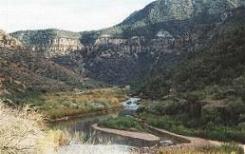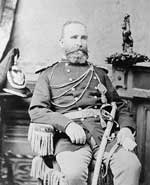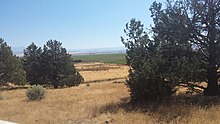
The Sand Creek massacre was a massacre of Cheyenne and Arapaho people by the U.S. Army in the American Indian Wars that occurred on November 29, 1864, when a 675-man force of the Third Colorado Cavalry under the command of U.S. Volunteers Colonel John Chivington attacked and destroyed a village of Cheyenne and Arapaho people in southeastern Colorado Territory, killing and mutilating an estimated 70–500 Native Americans, about two-thirds of whom were women and children. The location has been designated the Sand Creek Massacre National Historic Site and is administered by the National Park Service. This was part of a series of events known as the Colorado War and was preceded by the Hungate massacre.

George R. Crook was a career United States Army officer, most noted for his distinguished service during the American Civil War and the Indian Wars. During the 1880s, the Apache nicknamed Crook Nantan Lupan, which means "Chief Wolf."

The American Indian Wars, also known as the American Frontier Wars, the First Nations Wars in Canada and the Indian Wars is the collective name for the various armed conflicts that were fought by European governments and colonists, and later by the United States and Canadian governments and American and Canadian settlers, against various American Indian and First Nation tribes. These conflicts occurred in North America from the time of the earliest colonial settlements in the 17th century until the early 20th century. The various wars resulted from a wide variety of factors, including cultural clashes, land disputes, and criminal acts committed. The European powers and their colonies also enlisted Indian tribes to help them conduct warfare against each other's colonial settlements. After the American Revolution, many conflicts were local to specific states or regions and frequently involved disputes over land use; some entailed cycles of violent reprisal.

The Battle of Washita River occurred on November 27, 1868 when Lt. Col. George Armstrong Custer’s 7th U.S. Cavalry attacked Black Kettle’s Southern Cheyenne camp on the Washita River.
The Snake War (1864–1868) was an irregular war fought by the United States of America against the "Snake Indians," the settlers' term for Northern Paiute, Bannock and Western Shoshone bands who lived along the Snake River. Fighting took place in the states of Oregon, Nevada, and California, and in Idaho Territory. Total casualties from both sides of the conflict numbered 1,762 dead, wounded, or captured.

The Apache Scouts were part of the United States Army Indian Scouts. Most of their service was during the Apache Wars, between 1849 and 1886, though the last scout retired in 1947. The Apache scouts were the eyes and ears of the United States military and sometimes the cultural translators for the various Apache bands and the Americans. Apache scouts also served in the Navajo War, the Yavapai War, the Mexican Border War and they saw stateside duty during World War II. There has been a great deal written about Apache scouts, both as part of United States Army reports from the field and more colorful accounts written after the events by non-Apaches in newspapers and books. Men such as Al Sieber and Tom Horn were sometimes the commanding officers of small groups of Apache Scouts. As was the custom in the United States military, scouts were generally enlisted with Anglo nicknames or single names. Many Apache Scouts received citations for bravery.

Infernal Caverns is the site of an 1867 battle between U.S. armed forces and Shoshone, Paiute, and Pit River Indians. Infernal Caverns Battleground is California Historical Landmark No. 16.

The Battle of Turret Peak occurred March 27, 1873 in the Arizona Territory between the United States Army and a group of Yavapai and Tonto Apaches as part of Lieutenant Colonel George Crook's campaign to return the natives to reservations.
The 1st Nevada Cavalry Battalion, or the Nevada Territory Cavalry Volunteers, was a unit raised for the Union army during the American Civil War. It remained in the west, garrisoning frontier posts, protecting emigrant routes, and engaged in scouting duties. The unit was disbanded in July 1866.

The Battle of Salt River Canyon, the Battle of Skeleton Cave, or the Skeleton Cave Massacre was the first principal engagement during the 1872 Tonto Basin Campaign under the command of Lieutenant Colonel George Crook. It was part of the Yavapai War from 1871 to 1875.
The First Battle of Pyramid Lake in 1860 was one of the opening conflicts of the Paiute War in Nevada between the American people and the Paiute people, who had resisted the increasing numbers of migrants who traveled the California Trail through their territory, taking scarce game and water resources, as well as altercations with the Pony Express.

Fort Harney was a United States Army outpost in eastern Oregon in the United States. It was named in honor of Brigadier General William S. Harney. Fort Harney was used as a supply depot and administrative headquarters from 1867 to 1880 during the Army's campaign against Northern Paiute bands in Eastern Oregon and the Bannock uprising in the same area. Today, nothing remains of Fort Harney except a small cemetery.

Chief Paulina or Pahninee was a Northern Paiute war leader noted for his successful guerrilla tactics. He is known to have been active from 1859 until his death in 1867.

William Russell Parnell was an Irish-born adventurer and soldier during the mid-to late 19th century. A member of the 17th Lancers during the Crimean War, he was one of the few survivors of the infamous Charge of the Light Brigade.

The Battle of Canyon de Chelly was fought in 1864 as part of the Navajo Wars. It was a successful operation for the United States Army which precipitated the Long Walk and was the final major military engagement between the Navajo and the Americans. The battle ended with the fall of the main Navajo settlements of Canyon de Chelly in present-day northern Arizona.

The Battle of Pecos River was fought in 1864 during the Navajo Wars. United States Army troops and Apache Scouts defeated a force of Navajo warriors next to the Pecos River in New Mexico. It is notable for being one of the many Indian war battles involving the California Column.
The Battle of Owyhee River took place during the Snake War in 1866 in response to Paiute attacks along the Owyhee River earlier that year.
The Battle of Steen's Mountain was a battle during the Snake War. In response to Paiute attacks in Idaho, Lt. Col. George Crook led a punitive expedition into southeast Oregon, defeating Chief Howluck at the Battle of Owyhee River. Continuing his pursuit, Crook again encountered the Chief Paunina's Paiute village at Steen's Mountain. As Crook ordered the charge, his horse bolted and carried him through the native village. Nevertheless, his men followed. Despite several close calls for Crook personally, his troopers' fire was accurate and inflicted heavy casualties. A month later Crook's men engaged in one final skirmish before Crook ended the expedition due to bad weather.

Fort Wicked was a ranch and stage station on the Overland Trail from 1864 to 1868 in present-day Merino, Colorado. A historical marker commemorating the ranch is located at US 6 and CR-2.5. The ranch itself was located near a ford of the South Platte River, near where US-6 now crosses over the river. It was one of the few places along the trail to Denver that withstood an attack by Native Americans in 1864. It was named Fort Wicked for the "bitter defence" made by Holon Godfrey.
The Hungate massacre involved the murder of the family of Nathan Hungate along Running Creek on June 11, 1864. It was a precipitating factor leading to the Sand Creek massacre of November 29, 1864.














